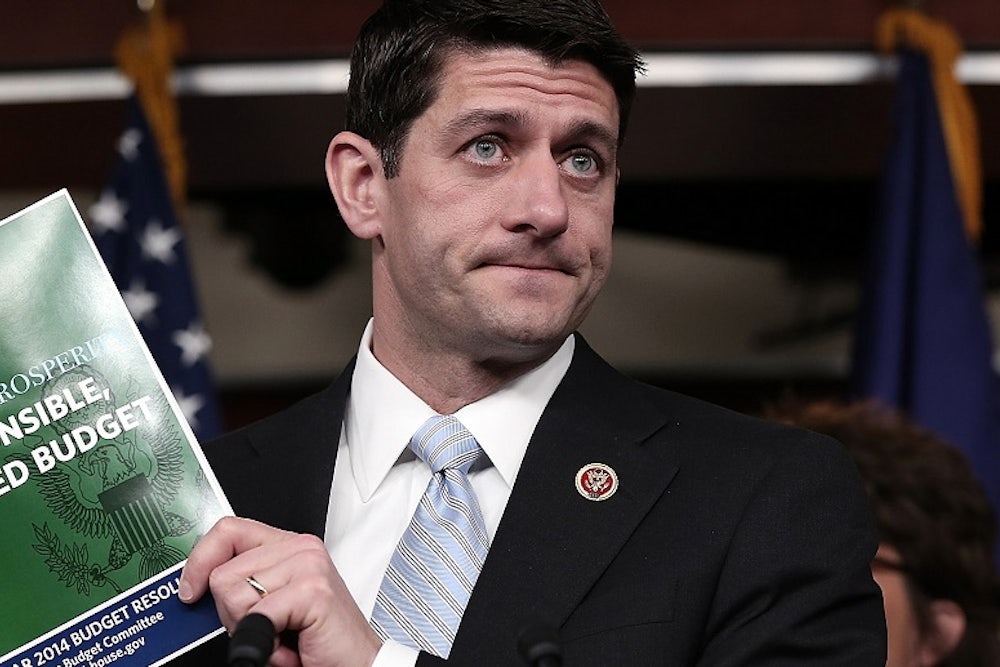Representative Paul Ryan on Tuesday released his 2015 budget, which eliminates the deficit in ten years by cutting spending by $5.1 trillion. But even with all of those cuts, the budget fails to balance the budget. Instead, Ryan relies on “dynamic scoring”—extra revenues from projected economic growth. Overall, there aren’t any big surprises this year, the last that Ryan will release a budget. Ryan is term-limited as chairman of the House Budget Committee and is expected to seek the chairmanship of the House Ways and Means committee—the powerful committee with jurisdiction over taxes.
Here are five quick thoughts. Ryan's budget…
…still repeals Obamacare
Many Republicans have accepted that the Affordable Care Act won't be repealed. Ryan is undeterred. “Left in place, the health law will create pressures that will eventually lead to a single-payer system,” his budget says.
…still offers nothing on Social Security
As in past years, Ryan’s 2015 budget does nothing to shore up the Social Security trust fund, instead telling the president to offer a plan: “This budget calls for setting in motion the process of reforming Social Security by altering a current-law trigger that, in the event that the Social Security program is not sustainable, requires the President, in conjunction with the Social Security Board of Trustees, to submit a plan for the restoring balance to the fund.”
…rejects Dave Camp’s tax plan without offering an alternative
On taxes, Ryan is committed to collapsing the federal income tax into two brackets with a top one at 25 percent and a bottom one at 10 percent. As we saw with Camp’s tax plan, that is just about impossible to do without increasing the deficit. Camp resorted to myriad scoring gimmicks and higher taxes, including raising the top rate to 35 percent. If Ryan does take over as Ways and Means chairman next year, as is expected, he has already constrained his ability to offer a deficit-neutral tax plan by committing himself to the two-rate structure.
…struggles to balance the budget
Ryan's goal of eliminating the deficit within 10 years was made even harder after the Congressional Budget Office revised down revenue projections by $1.4 trillion in February. Because he opposes raising taxes, Ryan is seeking steeper spending cuts to non-defense discretionary spending in particular—programs that disproportionately benefit low-income Americans. In 2024, non-defense discretionary spending would be $467 billion, well below its 2013 level of $576 billion.
As in past years, Ryan's budget cuts billions from Medicare by switching to “premium support.” His 2014 budget would have not have affected people aged 55 or over in 2014. This year, Ryan squeezed out additional savings by increasing that age limit by a year: Only those people who are 56 or over in 2015 are exempted from the premium support plan.
Even that wasn’t enough though to balance the budget. Ryan resorted to counting $74 billion of “fiscal dividend” in 2024 to close the gap. This controversial scoring method, which Democrats have long opposed, assumes that the budget will unlock economic growth and increase government revenues. Ryan has not included it in past years.
…has little meaning
Congress has already agreed to a topline figure of $1.014 trillion for fiscal year 2015, and Ryan does not change it. This could anger some conservatives who wanted to restore the sequester’s cuts in full. If enough House Republicans defect, it would make passage more difficult, especially since no Democrats will support the budget.
